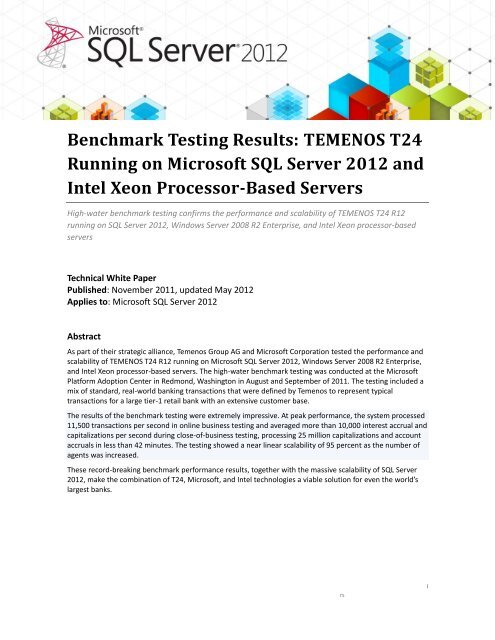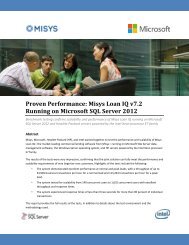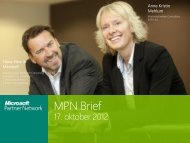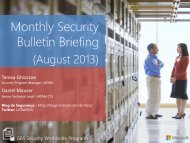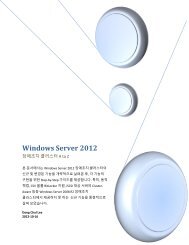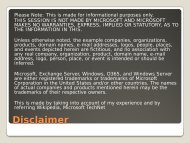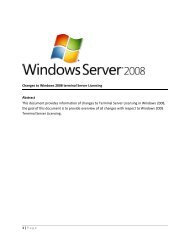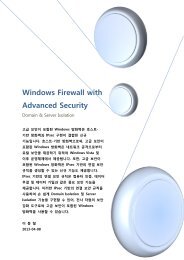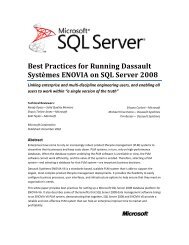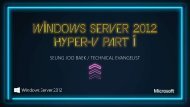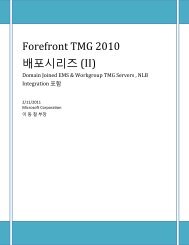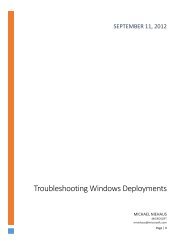TEMENOS T24, Microsoft SQL Server 2012, and ... - TechNet Blogs
TEMENOS T24, Microsoft SQL Server 2012, and ... - TechNet Blogs
TEMENOS T24, Microsoft SQL Server 2012, and ... - TechNet Blogs
You also want an ePaper? Increase the reach of your titles
YUMPU automatically turns print PDFs into web optimized ePapers that Google loves.
©<strong>2012</strong> <strong>Microsoft</strong> Corporation. All rights reserved. This document is provided “as-is.” Information <strong>and</strong> viewsexpressed in this document, including URL <strong>and</strong> other Internet Web site references, may change without notice.You bear the risk of using it.This document does not provide you with any legal rights to any intellectual property in any <strong>Microsoft</strong> product.You may copy <strong>and</strong> use this document for your internal, reference purposes.Benchmark Testing Results: <strong>TEMENOS</strong> <strong>T24</strong>, <strong>Microsoft</strong> <strong>SQL</strong> <strong>Server</strong> <strong>2012</strong>, <strong>and</strong> Intel Xeon Processor-Based <strong>Server</strong>sii
Table of ContentsIntroduction .................................................................................................................................................. 1Overview of <strong>TEMENOS</strong> <strong>T24</strong>............................................................................................................................... 1Benefits of <strong>SQL</strong> <strong>Server</strong> <strong>2012</strong> .............................................................................................................................. 4Benefits of Intel Processor-Based <strong>Server</strong>s ......................................................................................................... 5Better Together: <strong>Microsoft</strong>, Intel, <strong>and</strong> Temenos .............................................................................................. 5High-Water Benchmark Testing Overview ..................................................................................................... 7Benchmark Testing Environment ................................................................................................................... 7Benchmark Test Results: Record-Breaking Performance ............................................................................. 12Detailed Results of Online Business Test ........................................................................................................ 12Detailed Results of Close-of-Business Test ..................................................................................................... 14Scalability ....................................................................................................................................................... 15Conclusion ................................................................................................................................................... 15Additional Information ................................................................................................................................ 16About Temenos .............................................................................................................................................. 16About XIO ....................................................................................................................................................... 16About <strong>Microsoft</strong>.............................................................................................................................................. 16About Intel ...................................................................................................................................................... 16Benchmark Testing Results: <strong>TEMENOS</strong> <strong>T24</strong>, <strong>Microsoft</strong> <strong>SQL</strong> <strong>Server</strong> <strong>2012</strong>, <strong>and</strong> Intel Xeon Processor-Based <strong>Server</strong>siii
IntroductionFinancial institutions today are under increasing pressure to provide more services, more quickly,<strong>and</strong> to more customers around the globe—all while maintaining scrupulous security <strong>and</strong> keepingcosts low. Players in the financial services sector must constantly consider speed of processing, datasecurity, reliability, development capabilities, ease of integration, <strong>and</strong> cost. These intensecompetitive pressures mean that financial institutions need to operate as efficiently as possible atall times.With <strong>TEMENOS</strong> <strong>T24</strong> (<strong>T24</strong>), the Temenos Group provides a complete banking solution to help meetthese challenges. <strong>T24</strong> provides a single, real-time view of client computers across the entireenterprise, enabling banks to maximize returns while also streamlining costs.<strong>Microsoft</strong> <strong>SQL</strong> <strong>Server</strong> running on Intel processor-based servers provides an ideal data managementframework for <strong>TEMENOS</strong> <strong>T24</strong>. With this foundation, <strong>T24</strong> customers can experience faster fundstransfers, higher security-trades volumes, <strong>and</strong> quicker close-of-business processes; they can benefitfrom open, state-of-the-art technologies to accelerate innovation, which helps to greatly increasethe speed <strong>and</strong> effectiveness with which new products <strong>and</strong> services are created.To confirm the scalability <strong>and</strong> performance of <strong>T24</strong> running on <strong>SQL</strong> <strong>Server</strong> <strong>and</strong> Intel Xeon processorbasedservers, Temenos, <strong>Microsoft</strong>, <strong>and</strong> Intel conducted high-water benchmark tests at the<strong>Microsoft</strong> Platform Adoption Center (PAC) in Redmond, Washington, in August <strong>and</strong> September of2011. These benchmarking tests were designed to measure the capability of <strong>T24</strong> to process onlinetransactions that represent typical activity during business hours <strong>and</strong> the close-of-businesscapability to run the end-of-day batch processes. The transaction test cases <strong>and</strong> mix percentageswere compiled from Temenos client computers to simulate the real-world scenarios <strong>and</strong> the dailyprocessing load of a large retail bank with a typical transaction history.The results of the high-water benchmark test exceeded expectations. The system processed morethan 11,500 transactions per second (TPS) in online testing <strong>and</strong> averaged more than 10,000 interestaccrual <strong>and</strong> capitalizations per second during close-of-business processing with near linearscalability (95 percent) as the number of agents used was increased.This report details the results of the high-water benchmark testing, <strong>and</strong> describes the hardware <strong>and</strong>software used for the testing. Links for further information are also provided.Overview of <strong>TEMENOS</strong> <strong>T24</strong>Temenos Group AG, founded in 1993, is the market-leading provider of integrated core bankingsystems, giving banks a single, real-time view of the client across the enterprise. Headquartered inGeneva, Switzerl<strong>and</strong>, Temenos has more than 1,500 customers <strong>and</strong> 700 implementations in morethan 125 countries.Benchmark Testing Results: <strong>TEMENOS</strong> <strong>T24</strong>, <strong>Microsoft</strong> <strong>SQL</strong> <strong>Server</strong> <strong>2012</strong>, <strong>and</strong> Intel Xeon Processor-Based <strong>Server</strong>s1
<strong>TEMENOS</strong> <strong>T24</strong> is a fully integrated, modular core banking solution that covers a broad spectrum offunctional requirements for the retail, private, corporate, universal, <strong>and</strong> Islamic banking <strong>and</strong>microfinance sectors. <strong>T24</strong> consists of a core system for the common operations between the variousbanking activities <strong>and</strong> a series of modules that address the operational requirements of differentusers. <strong>T24</strong> is built on an open architecture <strong>and</strong> uses established st<strong>and</strong>ards such as HTTP <strong>and</strong> XML.<strong>T24</strong> is available as a Model Bank implementation, which embodies st<strong>and</strong>ard business practices builton the experience of a large number of <strong>T24</strong> implementations around the globe. The Model Bankincludes thous<strong>and</strong>s of pre-configured solutions for most general banking requirements.Additionally, <strong>T24</strong> can be customized on-site to match specific customer requirements forunmatched product flexibility.The <strong>T24</strong> solution consists of several layers, as shown in Figure 1, including:User access.Presentation (client computers).Messaging/connectivity (web servers).Application (application servers).Database (database servers).Figure 1. <strong>T24</strong> infrastructureBenchmark Testing Results: <strong>TEMENOS</strong> <strong>T24</strong>, <strong>Microsoft</strong> <strong>SQL</strong> <strong>Server</strong> <strong>2012</strong>, <strong>and</strong> Intel Xeon Processor-Based <strong>Server</strong>s 2
<strong>T24</strong> Scalability <strong>and</strong> Resilience<strong>T24</strong> can be implemented within a simple client computer <strong>and</strong> single server architecture, or <strong>T24</strong> canscale up to a full n-tier architecture that employs multiple servers in each tier.This flexibility in solution architecture makes it possible for Temenos to work with banks todetermine the most appropriate technical systems configuration that meets a bank’s resilience,redundancy, performance, <strong>and</strong> budgetary requirements.<strong>T24</strong> scales dynamically, <strong>and</strong> servers can be added during live operations without affecting theservice provision. This ability to “adapt” in a live environment has very powerful implications from aresilience perspective. Should a <strong>T24</strong> server fail, the other servers recover <strong>and</strong> absorb the failedserver’s load online until the failure issue is addressed <strong>and</strong> the original server can be reintroduced.This high level of resilience is critical for supporting today’s dem<strong>and</strong>s for global or 24x7 processing,<strong>and</strong> resilience is a cornerstone of <strong>T24</strong>’s ability to support a truly “around-the-clock” environment.Integration <strong>and</strong> Full Interconnectivity with <strong>T24</strong><strong>T24</strong> is channel neutral <strong>and</strong> offers a common architecture for all channels to interact <strong>and</strong> invokefunctionality within the application. The <strong>T24</strong> presentation layer is abstracted from the application.All front-end channels, including the browser client, use a common, industry-st<strong>and</strong>ard accessmechanism to connect to the application layer.The basis for this connectivity is the use of XML messaging through the Temenos open connectivityframework <strong>and</strong> the Open Financial Service (OFS) module. OFS is a message-based, real-time, onlineinterface that exposes all <strong>T24</strong> functionality <strong>and</strong>, provided the appropriate security criteria are inplace, also exposes the entire <strong>T24</strong> database to external, message-based systems.This ability to integrate with a bank’s requirements for interconnectivity extends to industry-leadingservice-oriented architecture (SOA) environments; every single <strong>T24</strong> transaction, enquiry, orworkflow process can be exposed as a web service. This capability hinges on the application’sinherent business service definition model, which renders every transaction deployable by using<strong>T24</strong> web services tooling. Because the application was developed to adhere to key web servicesst<strong>and</strong>ards <strong>and</strong> SOA principles, this deployment mechanism produces high-quality, consistent webservices definitions. These web services definitions provide application interoperability withindustry-st<strong>and</strong>ard enterprise service buses (ESBs) <strong>and</strong> associated applications, such as BusinessProcess Execution Language (BPEL) engines, among others.For more information about <strong>T24</strong>, see the <strong>TEMENOS</strong> <strong>T24</strong> home page.Benchmark Testing Results: <strong>TEMENOS</strong> <strong>T24</strong>, <strong>Microsoft</strong> <strong>SQL</strong> <strong>Server</strong> <strong>2012</strong>, <strong>and</strong> Intel Xeon Processor-Based <strong>Server</strong>s 3
Benefits of <strong>SQL</strong> <strong>Server</strong> <strong>2012</strong><strong>SQL</strong> <strong>Server</strong> <strong>2012</strong> provides a reliable, cost-effective, low-maintenance database framework for <strong>T24</strong>that can support the largest <strong>and</strong> most process-intensive deployments. <strong>SQL</strong> <strong>Server</strong> is acomprehensive, integrated, <strong>and</strong> enterprise-ready data-management software solution. Hundreds ofenterprises are currently running 10 terabyte <strong>and</strong> larger transactional databases on <strong>SQL</strong> <strong>Server</strong>.<strong>SQL</strong> <strong>Server</strong> <strong>2012</strong> sets the new st<strong>and</strong>ard for mission critical with industry-required high availability<strong>and</strong> performance capabilities at a leading total cost of ownership (TCO). Running <strong>T24</strong> on <strong>SQL</strong> <strong>Server</strong><strong>2012</strong> provides Temenos customers with many benefits, including:Scalability <strong>and</strong> performance<strong>SQL</strong> <strong>Server</strong> <strong>2012</strong> supports up to 640 logical processors <strong>and</strong> 4 TB of RAM on Windows <strong>Server</strong>8 (256 logical processors <strong>and</strong> 2 TB RAM on Windows <strong>Server</strong> 2008 R2) for high performanceof very large workloads. <strong>SQL</strong> <strong>Server</strong> also includes many features that can help Temenoscustomers scale up <strong>and</strong> scale out as their businesses grow.Lower hardware costs<strong>SQL</strong> <strong>Server</strong> runs on st<strong>and</strong>ard commodity server hardware, dramatically lowering the TCOwhen compared to mainframe hardware.Lower software costsWith <strong>SQL</strong> <strong>Server</strong>, customers can typically enjoy a 3:1 reduction in licensing costs comparedto the largest competitor. 1 Simpler systems management <strong>and</strong> lower staffing costs 2<strong>SQL</strong> <strong>Server</strong> database administrators (DBAs) can typically manage four times as manyphysical databases as a competitor’s DBAs. 3 Lower administration costs 4<strong>SQL</strong> <strong>Server</strong> delivers a 460 percent savings in annual costs of administration per databaseover that of the largest competitor.Fewer security vulnerabilities<strong>SQL</strong> <strong>Server</strong> consistently has fewer security vulnerabilities than the largest competitor. 5With <strong>SQL</strong> <strong>Server</strong>, Temenos customers can save with reduced licensing, hardware, administration,<strong>and</strong> support fees, which translates into substantially lower costs over the system's life.For more information about <strong>SQL</strong> <strong>Server</strong> <strong>2012</strong>, see the <strong>SQL</strong> <strong>Server</strong> home page.1 http://www.microsoft.com/sqlserver/en/us/tools/cost-savings-calclator.aspx2 http://www.microsoft.com/sqlserver/2008/en/us/compare-oracle.aspx3 http://www.microsoft.com/sqlserver/en/us/product-info/why-sql-server.aspx4 http://www.microsoft.com/sqlserver/en/us/product-info/why-sql-server.aspx5 NIST National Vulnerability Database, http://nvd.nist.gov/Benchmark Testing Results: <strong>TEMENOS</strong> <strong>T24</strong>, <strong>Microsoft</strong> <strong>SQL</strong> <strong>Server</strong> <strong>2012</strong>, <strong>and</strong> Intel Xeon Processor-Based <strong>Server</strong>s 4
Benefits of Intel Processor-Based <strong>Server</strong>sIntel Xeon processor-based servers are well suited to the dem<strong>and</strong>s of mission-critical bankingenvironments <strong>and</strong> provide dramatic cost savings in comparison with proprietary RISC <strong>and</strong>mainframe systems.As demonstrated by the benchmark testing environment (described later in this report), serversbased on the Intel Xeon E5 family are ideal for web <strong>and</strong> application servers at the front <strong>and</strong> middletiers of a banking solution. They are often deployed in distributed architectures that are highlyresilient <strong>and</strong> easily scaled through the addition of more servers.<strong>Server</strong>s based on the Intel Xeon processor E7 family provide the high-end scalability <strong>and</strong> availabilityneeded to support large, transaction-intensive databases. These larger <strong>and</strong> more robust serversinclude integrated support for all of the following.Scalable PerformanceA single eight-socket server based on the Intel Xeon processor E7 family provides up to 80processing cores, 160 threads, <strong>and</strong> 4 TB of memory for high-volume, transaction-intensive<strong>T24</strong> workloads. Large cache configurations (up to 30 MB per processor) keep frequentlyuseddata close to the processor cores to reduce latency <strong>and</strong> increase throughput.Data ProtectionAdvanced circuitry detects <strong>and</strong> corrects errors across all major subsystems <strong>and</strong>communication pathways <strong>and</strong> contains uncorrectable errors so they can’t poison otherdata.High AvailabilityBuilt-in failover <strong>and</strong> automatic reconfiguration capabilities help to maintain uninterruptedoperation. Intel Machine Check Architecture-Recovery works in t<strong>and</strong>em with <strong>Microsoft</strong>Windows <strong>Server</strong> to enable automated system recovery in complex error scenarios.ServiceabilityBuilt-in support for predictive failure analysis <strong>and</strong> partitioning enable problematiccomponents to be identified <strong>and</strong> replaced before they impact performance, <strong>and</strong> withoutbringing down the system for maintenance.Better Together: <strong>Microsoft</strong>, Intel, <strong>and</strong> TemenosTogether, <strong>Microsoft</strong>, Intel, <strong>and</strong> Temenos can provide cost benefits, along with optimal performance:An optimized technology stack for high performance <strong>and</strong> a low TCOo Industry-st<strong>and</strong>ard 32-bit <strong>and</strong> 64-bit hardware with a superior price/performance ratio.ooA smart “on-premises-to-cloud” platform strategy.<strong>Microsoft</strong> Services Premier Mission Critical, a scalable service <strong>and</strong> support program forthe most dem<strong>and</strong>ing solutions.Benchmark Testing Results: <strong>TEMENOS</strong> <strong>T24</strong>, <strong>Microsoft</strong> <strong>SQL</strong> <strong>Server</strong> <strong>2012</strong>, <strong>and</strong> Intel Xeon Processor-Based <strong>Server</strong>s 5
High-Water Benchmark Testing OverviewThe objective of the high-water benchmark testing was to measure the online business <strong>and</strong> close ofbusiness (COB) transaction scalability <strong>and</strong> throughput capacity of a <strong>T24</strong> R12 retail Model Bank onWindows <strong>Server</strong> 2008 R2, <strong>SQL</strong> <strong>Server</strong> <strong>2012</strong>, <strong>and</strong> Intel Xeon processor-based servers. Test cases <strong>and</strong>mix percentage were compiled from existing <strong>and</strong> prospective <strong>T24</strong> customers to simulate the realworldbanking scenarios.The benchmark testing looked at two key requirements for the core system of banks: performance<strong>and</strong> scalability.Two types of tests were run to measure <strong>T24</strong> performance:Online business scenario test (online test)The online business test measured the capability of <strong>T24</strong> to process online businesstransactions to represent typical activity during business hours in a large retail bank. Thetest used nine different types of transactions, including withdrawals, ATM transactions, <strong>and</strong>deposits.Interest accrual <strong>and</strong> capitalization test (COB test)The COB test measured the capability of <strong>T24</strong> to run the end-of-day batch processes for 25million accounts. The test consisted of a full <strong>T24</strong> month-end close-of-business run, as perst<strong>and</strong>ard <strong>T24</strong> benchmarking conditions. The primary processing job measured was theaccrual <strong>and</strong> capitalization of account interest.Targets for the benchmark testing were set by the Temenos Retail Banking Committee:The COB accrual <strong>and</strong> capitalization target was set to 7,000 TPS.The online testing target was set to 7,000 TPS during a one-hour period of peak activity ofthe core system. The maximum CPU utilization of database server during peak hour was not to exceed 75percent.Benchmark Testing EnvironmentThe benchmark testing environment was designed to emulate a realistic, large-scale retail bankingenvironment.The tests used Intel Xeon processor-based servers from Hewlett-Packard (HP) for the application<strong>and</strong> database tiers. The tests were run on 25 application servers connected to a central, singleinstance of <strong>SQL</strong> <strong>Server</strong> <strong>2012</strong> <strong>and</strong> Windows <strong>Server</strong> 2008 R2 Enterprise. The storage hardware usedwas the XIO Hyper ISE 14.4H. Hyper ISE uses Continuous Adaptive Data Placement (CADP)algorithms to identify <strong>and</strong> accelerate hot-spots on storage caused by the database. By continuouslymonitoring these hot-spots in real time, data is placed in the right storage media at the right time,with no administrative intervention required.Benchmark Testing Results: <strong>TEMENOS</strong> <strong>T24</strong>, <strong>Microsoft</strong> <strong>SQL</strong> <strong>Server</strong> <strong>2012</strong>, <strong>and</strong> Intel Xeon Processor-Based <strong>Server</strong>s 7
Table 1 shows details of the hardware.Table 1. Benchmark testing hardware detailsNumberof <strong>Server</strong>sMake <strong>and</strong>ModelCPU Architecture Cores RAMDatabase server1HP ProLiantDL980 G78 × 2.4 GHzIntel Xeonprocessor E7family (E7-2870)80 1024 GBApplication servers8HP ProLiantDL380 G72 × 2.8 GHz(X5660)Intel Xeonprocessor 5600series (X5660)6 core8 × 125 servers with64 GB3 servers with48 GB8HP ProLiantBL460c G62 × 2.53 GHz(E5540)Intel Xeonprocessor 5500series E5540)4 core8 × 8 48 GB8HP ProLiantBL490c G62 × 2.67 GHz(E5650)Intel Xeonprocessor 5600series (E5650)6 core8 × 12 48 GB1HP ProLiantDL580 G54 × 2.24 GHz(E7450)Intel Xeonprocessor 7400series (E7450)6 core1 × 24 64 GBTable 2 shows details of the storage used in the benchmark testing.Table 2. Storage detailsMake Model DetailsXIO Hyper ISE 14.4H2 DataPacs2 storage pools; each pool fuses 10 SSDs <strong>and</strong> 10 HDDs1 x 8 Gb/s HBA port [Qlogic 2560] to each pool3 terabytes storageBenchmark Testing Results: <strong>TEMENOS</strong> <strong>T24</strong>, <strong>Microsoft</strong> <strong>SQL</strong> <strong>Server</strong> <strong>2012</strong>, <strong>and</strong> Intel Xeon Processor-Based <strong>Server</strong>s 9
SoftwareTable 3 shows the details of the software used for the benchmark testing.Table 3. Details of software usedName <strong>and</strong> Version<strong>TEMENOS</strong> <strong>T24</strong> R12<strong>TEMENOS</strong> <strong>T24</strong> browserR11.2Jms-mq Injector 1.0 /MQ7<strong>SQL</strong> <strong>Server</strong> <strong>2012</strong>TAFC R11.0.0.1TOCF.NET R11.08.0.0.1UseApplication performance testingA web-based UI for the core banking system used to process <strong>and</strong> sendrequests to <strong>T24</strong> via the web serverUsed to inject Open Financial Services (OFS) messagesDatabaseApplication framework (runtime)Temenos Open Connectivity Framework, provides interface connectivityto <strong>T24</strong> from the MQ <strong>Server</strong>Data SetThe data set used in the benchmarking test reflects real-world banking activity volumes. Table 4shows the details.Table 4. Benchmark testing data setMetricsNumber of accountsNumber of customersNumber of branchesDirect channel peak-hour loadTransaction historyNumber of transactions per dayPeak online business loadNumber of applications servers25 million accounts (1 million of these foreign currency accounts)15 million customers2,000 branches (10 concurrent tellers/branch during peak hour)4 million accounts1-month full transaction history50.4 million transactions/day, half during a single peak hour50.4 million transactions/day, half during a single peak hour25 application servers running <strong>T24</strong>Benchmark Testing Results: <strong>TEMENOS</strong> <strong>T24</strong>, <strong>Microsoft</strong> <strong>SQL</strong> <strong>Server</strong> <strong>2012</strong>, <strong>and</strong> Intel Xeon Processor-Based <strong>Server</strong>s 10
Online Transaction LoadFor an online business transaction load of approximately 50 million transactions per eight-hour day,while accommodating a peak-hour load of 50 percent of all daily transactions, a <strong>T24</strong> businessscenario online test must meet a minimum throughput target of approximately 7,000 TPS.Table 5 details the transaction mix injected per channel type.Table 5. Transaction mixChannelATM <strong>and</strong>POSBranchofficetransactionsInternetbankingIVRClearingRepresentativeTransactionBalance inquiryCashwithdrawalTeller cashdepositOutwardclearingtransactions(collections)Savings bank(SB) accountopening(non-monetary)Funds transfer<strong>T24</strong> TransactionCustom RoutineOFS.GET.ACCT.BALANCEOFS Clearing Managerwith transaction requestTELLER,MB.DEPOSITInterfaceMixPercentageRequiredTPSOFS-MQ 5.0% 350OFS-MQ 25.0% 1,750XML-Browserweb2.0% 140FT,MB.OT OFS-MQ 0.5% 35ACCOUNT,MB.NEWFT,MB.ACCT.TO.ACCTXML-BrowserwebXML-Browserweb0.1% 72.0% 140Balance inquiry ENQ ACCT.BAL.TODAY OFS-MQ 21.0% 1,470Bank statement ENQ STMT.ENT.BOOK OFS-MQ 1.0% 70FinancialtransactioninquiryBalance inquiryClearingtransactionsENQ STMT.ENT.BOOK OFS-MQ 12.0% 840Custom RoutineOFS.GET.ACCT.BALANCEOFS CLEARINGMANAGER (BULK)OFS-MQ 8.0% 560OFS-MQ 23.4% 1,638TOTAL 100% 7,000Benchmark Testing Results: <strong>TEMENOS</strong> <strong>T24</strong>, <strong>Microsoft</strong> <strong>SQL</strong> <strong>Server</strong> <strong>2012</strong>, <strong>and</strong> Intel Xeon Processor-Based <strong>Server</strong>s 11
Benchmark Test Results: Record-BreakingPerformanceThe benchmarking test results show that <strong>SQL</strong> <strong>Server</strong> <strong>2012</strong> <strong>and</strong> Windows <strong>Server</strong> 2008 R2 Enterpriserunning on Intel Xeon processor-based servers provide record-breaking results for <strong>TEMENOS</strong> <strong>T24</strong>.Detailed Results of Online Business TestThe online business test was designed to simulate concentrated daily use of <strong>T24</strong> by injecting a highvolume of online transactions to the <strong>T24</strong> application.To achieve the correct mix of transactions at the correct TPS rate, Temenos allocated a “weight” toeach of the transaction types by injecting a number of transactions of various types in proportion towhat would be expected in the course of a typical business day’s processing.The throughput of online business transactions achieved was 11,592 per second, equal to morethan 83.4 million transactions in an eight-hour day with 50 percent of the day’s transactions in thepeak hour.Table 6 shows a summary of the online test results.Table 6. Summary of online test resultsMetricsTest durationAverage TPS75 minutes11,592 TPSTable 7 shows the CPU utilization results for the online testing. Note that 55.3 percent of the 280application server cores were used during the online testing.Table 7. Utilization results for online testingMake <strong>and</strong> Model Processor CPU LoadDatabase serverHP ProLiant DL980 G7 Intel Xeon processor E7-2870 49%Application serversHP ProLiant DL380 G7 Intel Xeon processor X5660 59.3%HP ProLiant BL460c G6 Intel Xeon processor E5540 41.2%HP ProLiant BL490c G6 Intel Xeon processor E5650 65.3%HP ProLiant DL580 G5 Intel Xeon processor E7450 37.0%TOTAL 55.3%Benchmark Testing Results: <strong>TEMENOS</strong> <strong>T24</strong>, <strong>Microsoft</strong> <strong>SQL</strong> <strong>Server</strong> <strong>2012</strong>, <strong>and</strong> Intel Xeon Processor-Based <strong>Server</strong>s 12
Table 8 shows details of the transaction mix used in the online business test <strong>and</strong> the online businesstest results by transaction type.Table 8. Results by transaction typeChannelRepresentative TransactionPercentAchievedTPS Measured(Required)ATM <strong>and</strong> POSBalance inquiry 5.0%Cash withdrawal 22.5%Teller cash deposit 1.5%580(350)2,610(1,750)170(140)Branch officetransactionsOutward clearing transactions(collections)0.4%46(35)SB account opening (nonmonetary)0.1%12.3(7)Internet bankingFunds transfer 1.5%Balance inquiry 22.1%Bank statement 1.0%Financial transaction inquiry 13.5%174(140)2,560(1,470)116(70)1,564(840)IVR Balance inquiry 8.5%Clearing Clearing transactions 24.0%980(560)2,780(1,638)TOTAL 100% 11,592.3Benchmark Testing Results: <strong>TEMENOS</strong> <strong>T24</strong>, <strong>Microsoft</strong> <strong>SQL</strong> <strong>Server</strong> <strong>2012</strong>, <strong>and</strong> Intel Xeon Processor-Based <strong>Server</strong>s 13
ScalabilityThe scalability of <strong>T24</strong> was demonstrated during the benchmark testing in several ways. Tests wererun on IC.COB capitalization by increasing the number of agents <strong>and</strong> measuring the capitalizationthroughput, looking for linear scalability.At the peak levels of transaction throughput, CPU utilization across the available server capacityremained below 75 percent, providing considerable additional capacity for further increases intransactions.Additionally, the application servers used were based on multiple generations of Intel Xeonprocessors, showing that customers can use existing <strong>and</strong> new hardware simultaneously to develop aresilient <strong>and</strong> scalable architecture.ConclusionTemenos, <strong>Microsoft</strong>, <strong>and</strong> Intel are working together to provide banking solutions that addresstoday’s industry challenges <strong>and</strong> dem<strong>and</strong>s in the most cost-effective way, while offering the agility torespond to the business <strong>and</strong> technology opportunities of tomorrow.The Temenos, <strong>Microsoft</strong>, <strong>and</strong> Intel high-water benchmark proves that <strong>SQL</strong> <strong>Server</strong> <strong>2012</strong> running onIntel Xeon processor-based servers can provide record-breaking performance for <strong>T24</strong>. <strong>T24</strong> running on <strong>SQL</strong> <strong>Server</strong> <strong>2012</strong> <strong>and</strong> Intel Xeon processor-based servers achieved 10,008TPS <strong>and</strong> processed 25 million capitalization <strong>and</strong> accruals of accounts in less than 42minutes.In an online business scenario test with a full transaction mix, <strong>T24</strong> running on <strong>SQL</strong> <strong>Server</strong><strong>2012</strong> <strong>and</strong> Intel Xeon processor-based servers achieved an impressive 11,592 TPS.These results make the combination of <strong>T24</strong>, <strong>Microsoft</strong> technologies, <strong>and</strong> Intel technologies anincreasingly compelling proposition for even the largest banks.Benchmark Testing Results: <strong>TEMENOS</strong> <strong>T24</strong>, <strong>Microsoft</strong> <strong>SQL</strong> <strong>Server</strong> <strong>2012</strong>, <strong>and</strong> Intel Xeon Processor-Based <strong>Server</strong>s 15
Additional InformationThe following references provide more information about Temenos, XIO, <strong>and</strong> <strong>Microsoft</strong>.About TemenosFounded in 1993 <strong>and</strong> listed on the Swiss Stock Exchange (SIX: TEMN), Temenos Group AG is themarket leading provider of banking software systems to retail, corporate, universal, private, Islamic<strong>and</strong> microfinance <strong>and</strong> community banks. Headquartered in Geneva with more than 60 officesworldwide, Temenos serves more than 1,500 customers in 125 countries. Temenos’ softwareproducts provide advanced technology <strong>and</strong> rich functionality, incorporating best-practice processesthat take advantage of Temenos’ experience in 700 implementations around the globe.For more information, visit: www.temenos.comAbout XIOXIO is the leader in performance-driven storage with incredible price/performance/capacity ratios.XIO pioneered the only True SHD storage system that amalgamates SSD <strong>and</strong> HDD into a single poolof storage, resulting in extreme performance that changes the economics of the data center.Enterprise-class reliability <strong>and</strong> ease of use are in XIO’s DNA—<strong>and</strong> are core aspects of all XIO storagesystems. XIO empowers enterprises to drive database performance to its limits.For more information, visit: www.xiostorage.comAbout <strong>Microsoft</strong>Founded in 1975, <strong>Microsoft</strong> (Nasdaq "MSFT") is the worldwide leader in software, services, <strong>and</strong>solutions that help people <strong>and</strong> businesses realize their full potential.For more information, visit: www.microsoft.comAbout IntelIntel is a world leader in computing innovation. The company designs <strong>and</strong> builds the essentialtechnologies that serve as the foundation for the world’s computing devices to continually advancehow people work <strong>and</strong> live.For more information about Intel products <strong>and</strong> services,visit: www.intel.comBenchmark Testing Results: <strong>TEMENOS</strong> <strong>T24</strong>, <strong>Microsoft</strong> <strong>SQL</strong> <strong>Server</strong> <strong>2012</strong>, <strong>and</strong> Intel Xeon Processor-Based <strong>Server</strong>s 16


